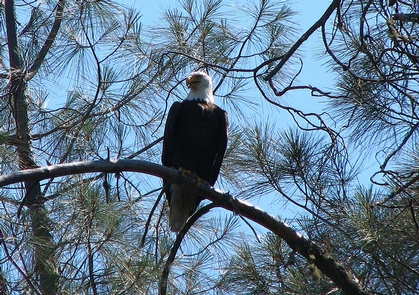Red Hills Recreation Management Area
Remember your OUTDOOR ETHICS when enjoying your public lands. Please RECREATE RESPONSIBLY.
NOTICE: Red Hills ACEC is Day Use Only. No camping on public lands within the Red Hills ACEC.
Overview
The Red Hills is a region of 7,100 acres of public land located near the intersection of State Highways 49 and 120, just south of the historic town of Chinese Camp in Tuolumne County. The Red Hills are noticeably different from the surrounding countryside. The serpentine-based soils in the area support a unique assemblage of plant species. Included among the thorny buckbrush and foothill pine is a rich variety of annual wildflowers. View Flickr Album to see the beauty of the Red Hills.
In the Red Hills buckbrush and other shrubs provide browse and seeds for small populations of mammals, including mule deer, jackrabbits, and rodents. Coyotes, bobcats and fox can also be found in the Red Hills. Approximately 88 bird species have been observed in the Red Hills. Some common species include mourning dove, acorn woodpecker, ash-throated flycatcher, scrub jay, wrentit, plain titmouse, bushtit, Bewick's wren, and house finch. Valley quail and mourning doves are the major game birds in the Red Hills.
An abundant insect population supports insectivorous birds including western kingbirds, ash- throated flycatcher, tree swallows, barn swallows, black phoebes, and others. Raptors include the red-tailed hawk, Cooper's hawk, prairie falcon, and great horned owl. Fish-eating birds seen in the Red Hills include the belted kingfisher and great blue heron. Roadrunners can also be found.
Wintering bald eagles roost along the shores of Don Pedro Reservoir and have been observed where Six Bit Gulch enters the lake. As many as 20 bald eagles have been sighted during the winter on the shores of Don Pedro Reservoir, roosting in stands of foothill pines.
Hunting and Shooting Info - Red Hills
- No target shooting
- Discharge of firearms is prohibited except in the course of licensed, in-season hunting activities
Hunting Wild Pigs at the Red Hills
Pig damage has been observed at the Red Hills. There are no restrictions or special regulations on hunting wild pigs within the Red Hills ACEC. Hunting is year round and there is no daily bag limit.
Please refer to the Department of Fish & Wildlife for additional information: https://wildlife.ca.gov/Hunting/Wild-Pig#194445-regulations
NOTE: All California game species are regulated by the California Department of Fish and Wildlife (CDFW). Rules, regulations, and seasons are controlled by CDFW, and it is the hunter's responsibility to verify and comply with proper species, seasons, zones, regulations, and legal location if hunting on public lands.
FGC 3004 — It is unlawful for any person to hunt or discharge while hunting, any firearm or other deadly weapon within 150 yards of any occupied dwelling house, residence, or other building or any barn or other outbuilding used in connection therewith. The 150 yard area is a "Safety Zone."
Helpful Links:
- Where to Shoot
- California Department of Fish & Wildlife
- Hunting, Fishing and Recreational Shooting on Public Lands, BLM California
Return To: BLM, Mother Lode Field Office
Photos
RED HILLS ACEC
Area of Critical Environmental Concern (ACEC)
The entire Red Hills Management Area has been designated as an ACEC. The purpose of the designation is to protect the rare plant species found there, the unusual serpentine soils that provide habitat for unique flora of the area, habitat for the rare minnow known as the Red Hills roach and to protect bald eagle wintering habitat.
The vegetation of the Red Hills is unique. The assemblage of plant species found there, including 7 rare plants, occurs nowhere else in the world. In the early spring the seemingly barren hills turn yellow, white, lavender and pink, with a spectacular wildflower display.
- Allium tuolumnense -- Rawhide Hill onion
- Chlorogalum grandiflorum -- Red Hills soaproot
- Cryptantha mariposae -- Mariposa cryptantha
- Lomatium congdonii -- Congdon's lomatium
- Packera (Senecio) layneae -- Layne's butterweed
- Senecio clevelandii var. heterophyllus -- Red Hills ragwort
- Verbena californica -- Red Hills vervain
Two plants occur only in the Red Hills: Red Hills vervain and Red Hills ragwort. They’re found only in wet areas, around creeks and springs. The other rare plants, Layne’s butterweed, Congdon’s lomatium, Mariposa cryptantha, Red Hills soaproot, and Rawhide Hill onion, grow in upland locations, and have been found on similar rock types outside the Red Hills.
To view photos of the rare plants within the Red Hills, go to:
CalPhotos website: https://calphotos.berkeley.edu/
Enter the common name of the plant and select the 'search' button.
VISITOR INFORMATION
Activities:
Hiking, horseback riding, wildflower viewing, birding, mountain biking, limited hunting. Target shooting is prohibited. Off-road vehicle use is prohibited.
Trail length:
Interpretive nature trail system with various loops, total of about 17.3 miles.
Facilities:
Restrooms and picnic tables available.
Permits, Fees, Limitations:
There are no fees to enter the site. Please note: A Special Recreation Use Permit is required for all competitive or commercial activities on public lands.
Wheelchair Accessibility: None.
Camping and Lodging:
There is no camping on public lands within the Red Hills ACEC.
Food and Supplies:
Food and supplies are available in Jamestown.
First Aid:
No first aid is available on-site. The nearest hospital is located in Sonora. First aid is available through the Volunteer Fire Department in Chinese Camp, Green Springs Station on Route J59.
Know before you go:
The best time to view wildflowers is late March through early May.
Phone
Activities
Geographic Coordinates
Directions
From Sonora, take State Highway 49 south 15-miles to Chinese Camp, then drive south on Red Hills Road for 1/2 mile.







